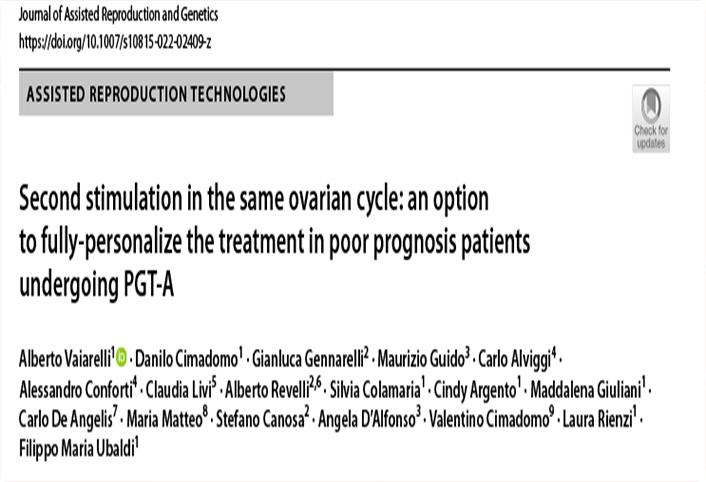

Journal of Assisted Reproduction and Genetics, https://doi.org/10.1007/s10815-022-02409-z
Alberto Vaiarelli, Danilo Cimadomo, Gianluca Gennarelli, Maurizio Guido, Carlo Alviggi, Alessandro Conforti, Claudia Livi, Alberto Revelli, Silvia Colamaria, Cindy Argento, Maddalena Giuliani, Carlo De Angelis, Maria Matteo, Stefano Canosa, Angela D’Alfonso, Valentino Cimadomo, Laura Rienzi, Filippo Maria Ubaldi
Journal of Assisted Reproduction and Genetics https://doi.org/10.1007/s10815-022-02409-z – Received: 22 October 2021 / Accepted: 17 January 2022
Abstract
Purpose Our primary objective was to assess whether immediately undergoing a second stimulation in the same ovarian cycle (DuoStim) for advanced-maternal-age and/or poor-ovarian-reserve (AMA/POR) patients obtaining ≤ 3 blastocysts for preimplantation-genetic-testing-for-aneuploidies (PGT-A) is more efficient than the conventional-approach.
Methods All AMA/POR patients obtaining ≤ 3 blastocysts after conventional-stimulation between 2017 and 2019 were proposed DuoStim, and 143 couples accepted (DuoStim-group) and were matched for the main confounders to 143 couples who did not accept (conventional-group). GnRH-antagonist protocol with recombinant-gonadotrophins and agonist trigger, intra-cytoplasmatic-sperm-injection (ICSI) with ejaculated sperm, PGT-A and vitrified-warmed euploid single-blastocyst- transfer(s) were performed. The primary outcome was the cumulative-live-birth-delivery-rate per intention-to-treat (CLBdR per ITT) within 1 year. If not delivering, the conventional-group had 1 year to undergo another conventional-stimulation. A cost-effectiveness analysis was also conducted.
Results The CLBdR was 10.5% in the conventional-group after the first attempt. Only 12 of the 128 non-pregnant patients returned (165 ± 95 days later; drop-out = 116/128,90.6%), and 3 delivered. Thus, the 1-year CLBdR was 12.6% (N = 18/143). In the DuoStim-group, the CLBdR was 24.5% (N = 35/143; p = 0.01), 2 women delivered twice and 13 patients have other euploid blastocysts after a LB (0 and 2 in the conventional-group). DuoStim resulted in an incremental-cost-effectiveness- ratio of 23,303€. DuoStim was costlier and more effective in 98.7% of the 1000 pseudo-replicates generated through boot- strapping, and the cost-effectiveness acceptability curves unveiled that DuoStim would be more cost-effective than the conventional-approach at a willingness-to-pay threshold of 23,100€.
Conclusions During PGT AtreatmentsinAMA/PORwomen,DuoStimcanbesuggestedinprogresstorescuepoorblastocyst yields after conventional-stimulation. It might indeed prevent drop-out or further aging between attempts.
